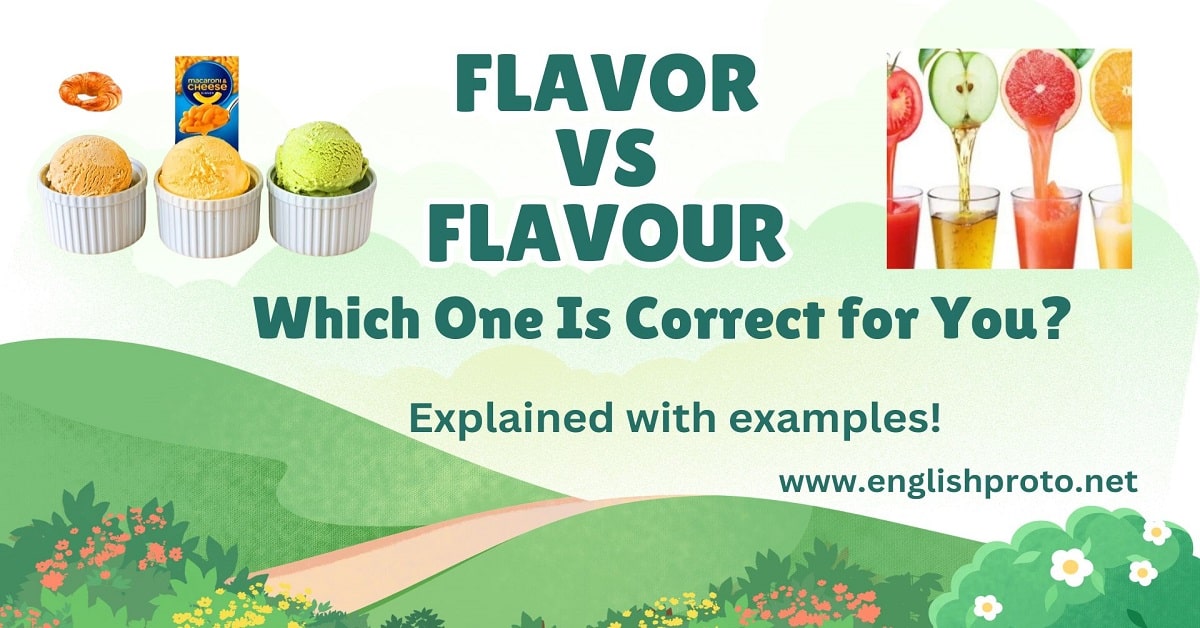Flavor vs Flavour: Which One Is Correct for You? It’s a debate that often causes confusion, even among the most seasoned writers.
Whether you’re crafting a blog post, preparing a menu, or simply curious about language, knowing the difference between these two spellings is key to sounding polished and professional. But here’s the catch: both are correct, just not in the same places.
So, why should you care? Well, getting it right can elevate your writing, help you connect with your audience, and avoid that cringe-worthy feeling when you spot an inconsistency. Keep reading to discover when to use flavor or flavour, and why it matters!
Quick Summary
- Flavor is the preferred spelling in American English.
- Flavour is used in British English and its variants, including Canadian English and Australian English.
- The meaning of both words is identical, referring to the distinctive taste or quality of something, often used in food and drink contexts.
- The key takeaway is that while the two spellings are interchangeable in meaning, you must choose the correct one based on your regional audience or the conventions you’re following in your writing.
Key Takeaways:
- Use flavor in American English contexts and when writing for an American audience.
- Use flavour for British, Canadian, Australian, or other English-speaking regions that follow British conventions.
- Consistency is important: Once you choose a spelling, stick with it throughout your document or piece of writing to maintain professionalism.
Reasons for Confusion: Flavor vs Flavour
There are several reasons why many people find themselves confused about whether to use flavor or flavour, despite both words having the same meaning. Here are the main causes:
1. Regional English Variations
The primary source of confusion stems from the difference between American English and British English spellings. Over time, the English language evolved differently in the United States and the United Kingdom. This is often due to the influence of historical, cultural, and linguistic factors.
In the United States, Noah Webster, a famous American lexicographer, simplified many English spellings in the 19th century in order to make the language more phonetic.
Webster’s dictionary played a significant role in standardizing American English spelling, which is why words like flavor (without the “u”) became the norm in American English.
In contrast, British English retained many of the original spellings, including the use of flavour. This difference continues today and is seen in many other words, such as colour vs color, favour vs favor, and honour vs honor.
2. Influence of Media and Globalization
As global communication grows, many people are exposed to both forms of English. With the internet, movies, TV shows, and books from both sides of the Atlantic being accessible worldwide, it’s easy to come across both spellings in everyday reading.
For people who are not familiar with the specific differences, this can create confusion about which version to use in their writing.
3. Similar Pronunciation
Another reason for the confusion is that flavor and flavour are pronounced exactly the same in both American and British English.
This similarity in sound might cause people to overlook the distinction in spelling and assume that either version is equally correct, especially if they are writing quickly or informally.
Detailed Explanation
Meaning of Flavor and Flavour
At the core, flavor and flavour are synonyms. They refer to the distinctive taste or quality that food, beverages, or even other products exhibit. This could be a taste that is sweet, salty, sour, bitter, or umami.
The words can also be used metaphorically to describe a certain “character” or “atmosphere” that something conveys. For instance, you might say that a person brings a unique flavor to a conversation or that a city has a certain flavor based on its cultural vibe.
Flavor (American spelling) and flavour (British spelling) are commonly used in:
- Food and beverage descriptions (e.g., “The chocolate ice cream has a rich flavor.”)
- Conversations about sensory experiences (e.g., “This wine has a fruity flavor.”)
- Figurative language to describe qualities or characteristics (e.g., “His speech had a distinct flavor of optimism.”)
Regional Preferences and Usage
Flavor in American English
In American English, the simplified form flavor is the standard. This spelling is used in all formal and informal contexts in the United States, and it’s the version you’ll see in American cookbooks, product descriptions, restaurant menus, and advertising.
Examples of flavor in American English:
- “What flavor of ice cream would you like?”
- “The salad dressing has a tangy flavor.”
- “She enjoys trying different flavors of coffee.”
Flavour in British English
In British English, the original French-inspired spelling flavour is maintained. You will see this version used throughout the UK, Canada, Australia, and other countries that follow British spelling conventions.
Examples of flavour in British English:
- “I prefer the flavour of organic honey over the processed variety.”
- “This curry has an intense flavour of garlic and chili.”
- “The new flavour of crisps has been a hit with customers.”
Why It’s Important to Choose the Right Spelling
Choosing the right spelling is crucial for clarity, consistency, and professionalism. If you are writing for an American audience, using flavour may cause confusion or appear incorrect.
Similarly, using flavor in a document intended for a British or international audience could make your writing seem inconsistent or even unprofessional.
Here’s how to navigate the spelling choices:
- Identify your audience: Are you writing for an American audience or a British audience? Your spelling should match the regional language norms.
- Stick to one version: Avoid switching between flavor and flavour in the same document. Choose one and remain consistent throughout your work.
- Be mindful of regional style guides: Many companies, schools, and publishing houses follow specific style guides (e.g., Chicago Manual of Style, Oxford English Dictionary) that outline which spellings to use. Check the preferred style guide before submitting any work.
Common Errors: Flavor vs Flavour
While both spellings are correct depending on the region, here are some common errors people make with flavor and flavour:
1. Mixing the Two
One of the most common mistakes is using flavor in one part of a sentence or document and flavour in another. This inconsistency can confuse your readers and undermine your credibility.
Incorrect:
- “The cake had a rich flavour, but the drink was lacking in flavor.”
Correct:
- “The cake had a rich flavour, but the drink was lacking in flavour.” (for British audiences)
- “The cake had a rich flavor, but the drink was lacking in flavor.” (for American audiences)
2. Assuming One Is Wrong
Many people mistakenly believe that one of the spellings is wrong, especially if they are used to seeing only one version in their region. However, as discussed earlier, both spellings are correct in their respective English varieties.
Incorrect:
- “The restaurant offered a flavour of dessert I’d never tried before.” (Incorrect for American English)
Correct:
- “The restaurant offered a flavor of dessert I’d never tried before.” (American English)
Synonyms and Alternatives
If you feel like mixing things up or want to avoid repetition, here are some synonyms or alternative phrases for flavor or flavour that can be used in different contexts:
- Taste: “The taste of the apple was sweet and tangy.”
- Savor: “I could savor the rich taste of the chocolate.”
- Essence: “The essence of the fruit was captured in the juice.”
- Zest: “The dish had a zest that was both spicy and citrusy.”
- Character: “The character of the wine was deep and earthy.”
These alternatives can add variety to your writing, whether you’re describing food, drinks, or even abstract concepts.
Examples in Sentences
To help clarify the distinction, here are a variety of examples showing flavor and flavour in sentences:
American English (Flavor):
- “This coffee has a bold flavor that wakes me up in the morning.”
- “The strawberry flavor is the most popular at this ice cream shop.”
- “She added a touch of flavor to the sauce with a pinch of garlic.”
British English (Flavour):
- “The new curry has a rich flavour of coriander.”
- “I love the flavour of freshly baked bread.”
- “This wine has a unique flavour that blends perfectly with the meal.”
Origins and History: Flavor vs Flavour
The word flavor comes from the Old French word flaveur, which was derived from flaver (to taste). It was adopted into Middle English and used similarly to refer to the quality of taste or scent.
Over time, flavour became the standard spelling in British English, while American English adopted the simplified form flavor after Noah Webster’s spelling reforms in the 19th century.
Webster’s changes were aimed at simplifying English spelling to make it more phonetic, which is why we see words like color instead of colour, theater instead of theatre, and flavor instead of flavour in American English.
Conclusion: Flavor vs Flavour
The flavor vs flavour debate boils down to one simple factor: regional spelling preferences. Both spellings are grammatically correct depending on which form of English you’re using, but understanding which one to use is essential for effective communication.
Recap:
- Flavor is used in American English.
- Flavour is used in British English and other countries that follow British conventions.
- Always be consistent in your spelling choice to avoid confusion.
- If in doubt, know your audience and use the correct version for them.
By understanding and applying the right spelling, your writing will feel polished, professional, and well-suited to the audience you’re addressing.



